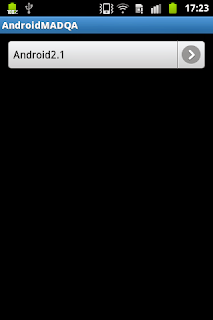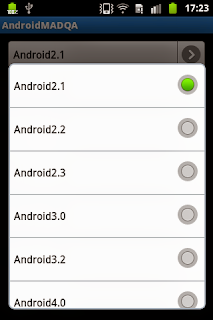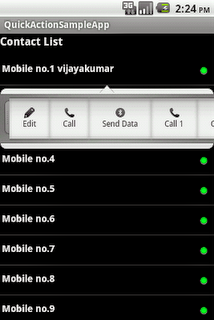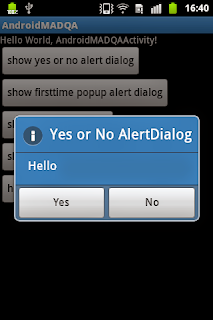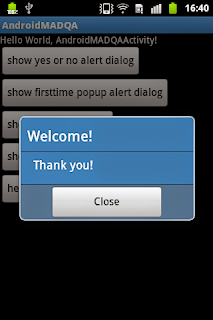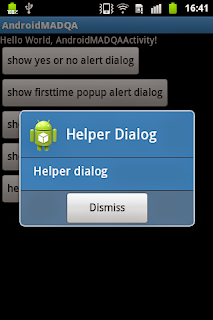Android ViewFlipper
-->
-->
-->
-->
-->
-->
Simple
ViewAnimator
that will animate between two or more views that have been added to
it. Only one child is shown at a time. If requested, can
automatically flip between each child at a regular interval.
Below i wrote the code for through flipping you can see the next ITEM or Previous Item with Animation.
Activity Code :
import
android.app.Activity;
import
android.os.Bundle;
import
android.view.View;
import
android.view.View.OnClickListener;
import
android.view.ViewGroup;
import
android.view.animation.AnimationUtils;
import
android.widget.Button;
import
android.widget.TextView;
import
android.widget.ViewFlipper;
/**
*
*
@author
vijayakumar
*
*/
public
class
AndroidMADQAActivity extends
Activity {
ViewFlipper flipper;
Button btn1_next
,btn_prev
,btn_playwithAnimation;
/**
*
This method called when activity started
*/
@Override
public
void
onCreate(Bundle savedInstanceState) {
super.onCreate(savedInstanceState);
Integer[] items = {
R.drawable.a,
R.drawable.e,R.drawable.d,R.drawable.c};
setContentView(R.layout.main);
btn1_next
= (Button)findViewById(R.id.button2);
btn_prev
= (Button)findViewById(R.id.button1);
btn_playwithAnimation
= (Button)findViewById(R.id.button3);
flipper
= (ViewFlipper) findViewById(R.id.viewFlipper1);
flipper.setInAnimation(AnimationUtils.loadAnimation(this,
R.anim.left_in));
flipper.setOutAnimation(AnimationUtils.loadAnimation(this,R.anim.left_out));
for
(Integer item : items) {
TextView textView = new
TextView(this);
textView.setTextSize(30);
textView.setBackgroundResource(item);
flipper.addView(textView,
new
ViewGroup.LayoutParams(
ViewGroup.LayoutParams.FILL_PARENT,
ViewGroup.LayoutParams.FILL_PARENT));
}
btn_playwithAnimation.setOnClickListener(new
OnClickListener() {
@Override
public
void
onClick(View v) {
if(flipper.isFlipping()){
flipper.stopFlipping();
}
flipper.setFlipInterval(1000);
flipper.startFlipping();
}
});
btn1_next.setOnClickListener(new
OnClickListener() {
@Override
public
void
onClick(View v) {
//
TODO
Auto-generated method stub
if(flipper.isFlipping()){
flipper.stopFlipping();
}
flipper.showNext();
}
});;
btn_prev.setOnClickListener(new
OnClickListener() {
@Override
public
void
onClick(View v) {
//
TODO
Auto-generated method stub
if(flipper.isFlipping()){
flipper.stopFlipping();
}
flipper.showPrevious();
}
});;
}
}
Screen Shot
main.xml
<?xml
version="1.0"
encoding="utf-8"?>
<LinearLayout
xmlns:android="http://schemas.android.com/apk/res/android"
android:orientation="vertical"
android:layout_width="fill_parent"
android:layout_height="fill_parent"
>
<ViewFlipper
android:id="@+id/viewFlipper1"
android:layout_width="match_parent"
android:layout_height="370dip"
>
</ViewFlipper>
<LinearLayout
android:orientation="horizontal"
android:layout_gravity="bottom"
android:padding="4dip"
android:background="#A4C639"
android:gravity="bottom"
android:layout_width="fill_parent"
android:layout_height="wrap_content"
>
<Button
android:id="@+id/button1"
android:layout_width="wrap_content"
android:layout_height="wrap_content"
android:text="Previous"
/>
<Button
android:id="@+id/button3"
android:layout_marginLeft="30dip"
android:layout_width="wrap_content"
android:layout_height="wrap_content"
android:text="Slide
Show" />
<Button
android:id="@+id/button2"
android:layout_width="wrap_content"
android:layout_marginLeft="30dip"
android:layout_height="wrap_content"
android:text="
Next " />
</LinearLayout>
</LinearLayout>
Animation XML
left_out.xml
<?xml
version="1.0"
encoding="utf-8"?>
<set
xmlns:android="http://schemas.android.com/apk/res/android">
<translate
android:fromXDelta="0"
android:toXDelta="-100%p"
android:duration="300"/>
<alpha
android:fromAlpha="1.0"
android:toAlpha="0.0"
android:duration="300"
/>
</set>
left_in.xml
<?xml
version="1.0"
encoding="utf-8"?>
<set
xmlns:android="http://schemas.android.com/apk/res/android">
<translate
android:fromXDelta="100%p"
android:toXDelta="0"
android:duration="300"/>
<alpha
android:fromAlpha="0.0"
android:toAlpha="1.0"
android:duration="300"
/>
</set>


